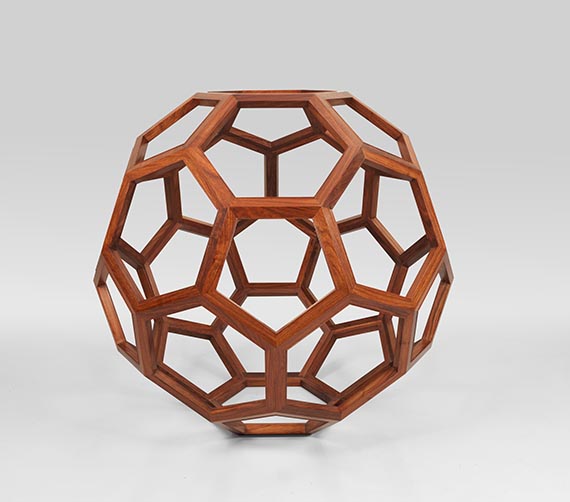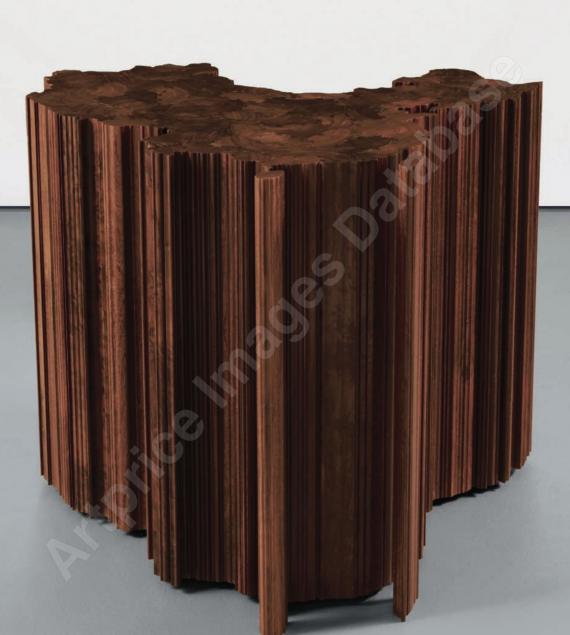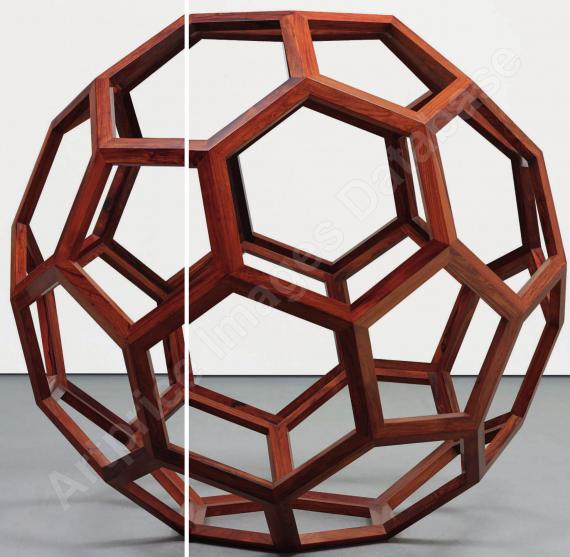Verso
Verso
Autre image
206
Ai Weiwei
F Size, 2011.
Huanghuali-Wood
Estimation: € 100,000 / $ 107,000
F Size. 2011.
Huanghuali-Wood.
Diameter: 130 cm (51.1 in).
• Ai WeiWei is considered one of the most important contemporary Chinese artists.
• Each sculpture is made by hand without the use of glue or nails.
• In structure and effect, the purest form of mathematical elegance.
• Huanghuali is a Chinese rosewood, a luxury material traditionally used to make exclusive furniture.
Accompanied by a certificate by the artist from November 2014.
PROVENANCE: Ivory Press, Madrid.
Lindon Gallery, London (directly from the above)
Private collection Switzerland (since 2014, acquired directly from the above).
Called up: June 7, 2024 - ca. 15.54 h +/- 20 min.
Huanghuali-Wood.
Diameter: 130 cm (51.1 in).
• Ai WeiWei is considered one of the most important contemporary Chinese artists.
• Each sculpture is made by hand without the use of glue or nails.
• In structure and effect, the purest form of mathematical elegance.
• Huanghuali is a Chinese rosewood, a luxury material traditionally used to make exclusive furniture.
Accompanied by a certificate by the artist from November 2014.
PROVENANCE: Ivory Press, Madrid.
Lindon Gallery, London (directly from the above)
Private collection Switzerland (since 2014, acquired directly from the above).
Called up: June 7, 2024 - ca. 15.54 h +/- 20 min.
The Beijing-born artist Ai Weiwei is best known for his conceptual, regime-critical artworks. In addition to installations and sculptures, his oeuvre also includes photographs, performances, film, and architecture. He deals with topics such as human rights, freedom of speech, and the environment, and attempts to establish multiple connections between traditional Chinese culture and the modern globalized world. These provocative interventions led him to be put under house arrest for weeks in 2010 and he was even imprisoned by the Chinese government in 2011.
The work offered here was created in the same year as part of the "Divina Proportione" series. The title of the series refers to a mathematical treatise by Luca Pacioli from the Renaissance with illustrations by Leonardo da Vinci. First published in 1509, the text discusses the application and significance of mathematical proportions in geometry, art, and architecture, which are expressed here in the perfect proportions of the Platonic body. Ai Weiwei's was inspired by a cat toy after which he modeled a geometric polyhedron out of wood. It was only after Ai Weiwei had completed his series of spheres made of squares and triangles that he discovered a very similar construction drawing by da Vinci. The structure and effect of these sculptures represent the purest form of mathematical elegance. Typically, Ai Weiwei combines something mundane with something very significant or traditional. Using a Chinese carpentry technique, the sculptures are put together without nails or screws. The woodworking technique, which dates back to the Ming dynasty, subtly references Chinese culture, particularly Chinese furniture art. Carved wooden parts are seamlessly interconnected using a complex system of joints. The type of wood he uses is also a reference, as Ai Weiwei uses Huanghuali wood, Chinese rosewood, which is traditionally used for exclusive pieces of furniture, thus allowing for several levels of interpretation. On the one hand, it evokes art-historical associations through the da Vinci reference in the title and the circular form, on the other, regional-historical associations through the technology employed. [MH/SM]
The work offered here was created in the same year as part of the "Divina Proportione" series. The title of the series refers to a mathematical treatise by Luca Pacioli from the Renaissance with illustrations by Leonardo da Vinci. First published in 1509, the text discusses the application and significance of mathematical proportions in geometry, art, and architecture, which are expressed here in the perfect proportions of the Platonic body. Ai Weiwei's was inspired by a cat toy after which he modeled a geometric polyhedron out of wood. It was only after Ai Weiwei had completed his series of spheres made of squares and triangles that he discovered a very similar construction drawing by da Vinci. The structure and effect of these sculptures represent the purest form of mathematical elegance. Typically, Ai Weiwei combines something mundane with something very significant or traditional. Using a Chinese carpentry technique, the sculptures are put together without nails or screws. The woodworking technique, which dates back to the Ming dynasty, subtly references Chinese culture, particularly Chinese furniture art. Carved wooden parts are seamlessly interconnected using a complex system of joints. The type of wood he uses is also a reference, as Ai Weiwei uses Huanghuali wood, Chinese rosewood, which is traditionally used for exclusive pieces of furniture, thus allowing for several levels of interpretation. On the one hand, it evokes art-historical associations through the da Vinci reference in the title and the circular form, on the other, regional-historical associations through the technology employed. [MH/SM]
206
Ai Weiwei
F Size, 2011.
Huanghuali-Wood
Estimation: € 100,000 / $ 107,000
Commission, taxes et droit de suite
Cet objet est offert avec imposition différentielle majorée d'une taxe à l'importation qui s'élève à 7% (réduction d'environ 5% par rapport à l'imposition régulière) ou avec imposition régulière.
Calcul en cas d'imposition différentielle:
Prix d’adjudication jusqu’à 800 000 euros : frais de vente 32 %.
Des frais de vente de 27% sont facturés sur la partie du prix d’adjudication dépassant 800 000 euros. Ils sont additionnés aux frais de vente dus pour la partie du prix d’adjudication allant jusqu’à 800 000 euros.
Des frais de vente de 22% sont facturés sur la partie du prix d’adjudication dépassant 4 000 000 euros. Ils sont additionnés aux frais de vente dus pour la partie du prix d’adjudication allant jusqu’à 4 000 000 euros.
Le prix de vente inclut la taxe sur la valeur ajoutée, actuellement de 19%.
Calcul en cas d'imposition régulière:
Prix d’adjudication jusqu’à 800 000 euros : frais de vente 27%.
Des frais de vente de 21% sont facturés sur la partie du prix d’adjudication dépassant 800 000 euros. Ils sont additionnés aux frais de vente dus pour la partie du prix d’adjudication allant jusqu’à 800 000 euros.
Des frais de vente de 15 % sont facturés sur la partie du prix d’adjudication dépassant 4 000 000 euros. Ils sont additionnés aux frais de vente dus pour la partie du prix d’adjudication allant jusqu’à 4 000 000 euros.
La taxe sur la valeur ajoutée allemande, actuellement de 19 %, est perçue sur la somme du prix d’adjudication et des frais de vente. Exception : la taxe sur la valeur ajoutée réduite de 7 % est appliquée pour les livres imprimés.
Pour les entreprises habilitées à déduire la TVA, le régime fiscal général peut être appliqué.
Calcul en cas de droit de suite:
Pour les œuvres originales d’arts plastiques et de photographie d’artistes vivants ou d’artistes décédés il y a moins de 70 ans, soumises au droit de suite, une rémunération au titre du droit de suite à hauteur des pourcentages indiqués au § 26, al. 2 de la loi allemande sur les droits d’auteur (UrhG) est facturée en sus pour compenser la rémunération liée au droit de suite due par le commissaire-priseur conformément au § 26 UrhG. À ce jour, elle est calculée comme suit :
4 pour cent pour la part du produit de la vente à partir de 400,00 euros et jusqu’à 50 000 euros,
3 pour cent supplémentaires pour la part du produit de la vente entre 50 000,01 et 200 000 euros,
1 pour cent supplémentaire pour la part entre 200 000,01 et 350 000 euros,
0,5 pour cent supplémentaire pour la part entre 350 000,01 et 500 000 euros et
0,25 pour cent supplémentaire pour la part au-delà de 500 000 euros.
Le total de la rémunération au titre du droit de suite pour une revente s’élève au maximum à 12 500 euros.
Calcul en cas d'imposition différentielle:
Prix d’adjudication jusqu’à 800 000 euros : frais de vente 32 %.
Des frais de vente de 27% sont facturés sur la partie du prix d’adjudication dépassant 800 000 euros. Ils sont additionnés aux frais de vente dus pour la partie du prix d’adjudication allant jusqu’à 800 000 euros.
Des frais de vente de 22% sont facturés sur la partie du prix d’adjudication dépassant 4 000 000 euros. Ils sont additionnés aux frais de vente dus pour la partie du prix d’adjudication allant jusqu’à 4 000 000 euros.
Le prix de vente inclut la taxe sur la valeur ajoutée, actuellement de 19%.
Calcul en cas d'imposition régulière:
Prix d’adjudication jusqu’à 800 000 euros : frais de vente 27%.
Des frais de vente de 21% sont facturés sur la partie du prix d’adjudication dépassant 800 000 euros. Ils sont additionnés aux frais de vente dus pour la partie du prix d’adjudication allant jusqu’à 800 000 euros.
Des frais de vente de 15 % sont facturés sur la partie du prix d’adjudication dépassant 4 000 000 euros. Ils sont additionnés aux frais de vente dus pour la partie du prix d’adjudication allant jusqu’à 4 000 000 euros.
La taxe sur la valeur ajoutée allemande, actuellement de 19 %, est perçue sur la somme du prix d’adjudication et des frais de vente. Exception : la taxe sur la valeur ajoutée réduite de 7 % est appliquée pour les livres imprimés.
Pour les entreprises habilitées à déduire la TVA, le régime fiscal général peut être appliqué.
Calcul en cas de droit de suite:
Pour les œuvres originales d’arts plastiques et de photographie d’artistes vivants ou d’artistes décédés il y a moins de 70 ans, soumises au droit de suite, une rémunération au titre du droit de suite à hauteur des pourcentages indiqués au § 26, al. 2 de la loi allemande sur les droits d’auteur (UrhG) est facturée en sus pour compenser la rémunération liée au droit de suite due par le commissaire-priseur conformément au § 26 UrhG. À ce jour, elle est calculée comme suit :
4 pour cent pour la part du produit de la vente à partir de 400,00 euros et jusqu’à 50 000 euros,
3 pour cent supplémentaires pour la part du produit de la vente entre 50 000,01 et 200 000 euros,
1 pour cent supplémentaire pour la part entre 200 000,01 et 350 000 euros,
0,5 pour cent supplémentaire pour la part entre 350 000,01 et 500 000 euros et
0,25 pour cent supplémentaire pour la part au-delà de 500 000 euros.
Le total de la rémunération au titre du droit de suite pour une revente s’élève au maximum à 12 500 euros.




 Lot 206
Lot 206 

